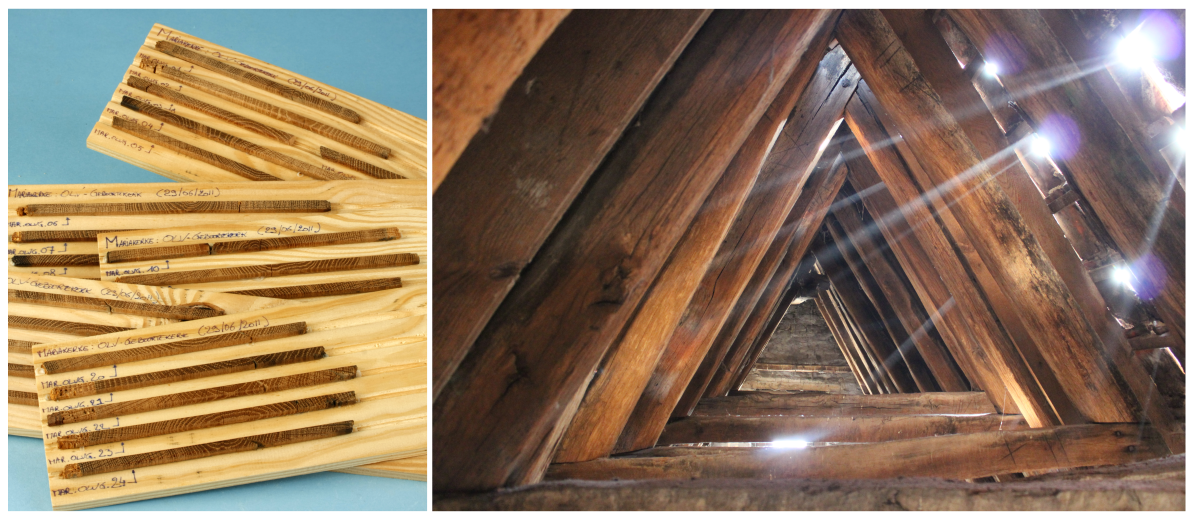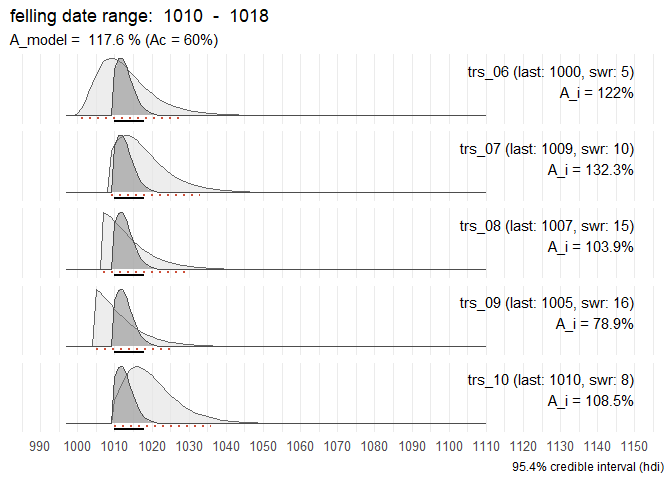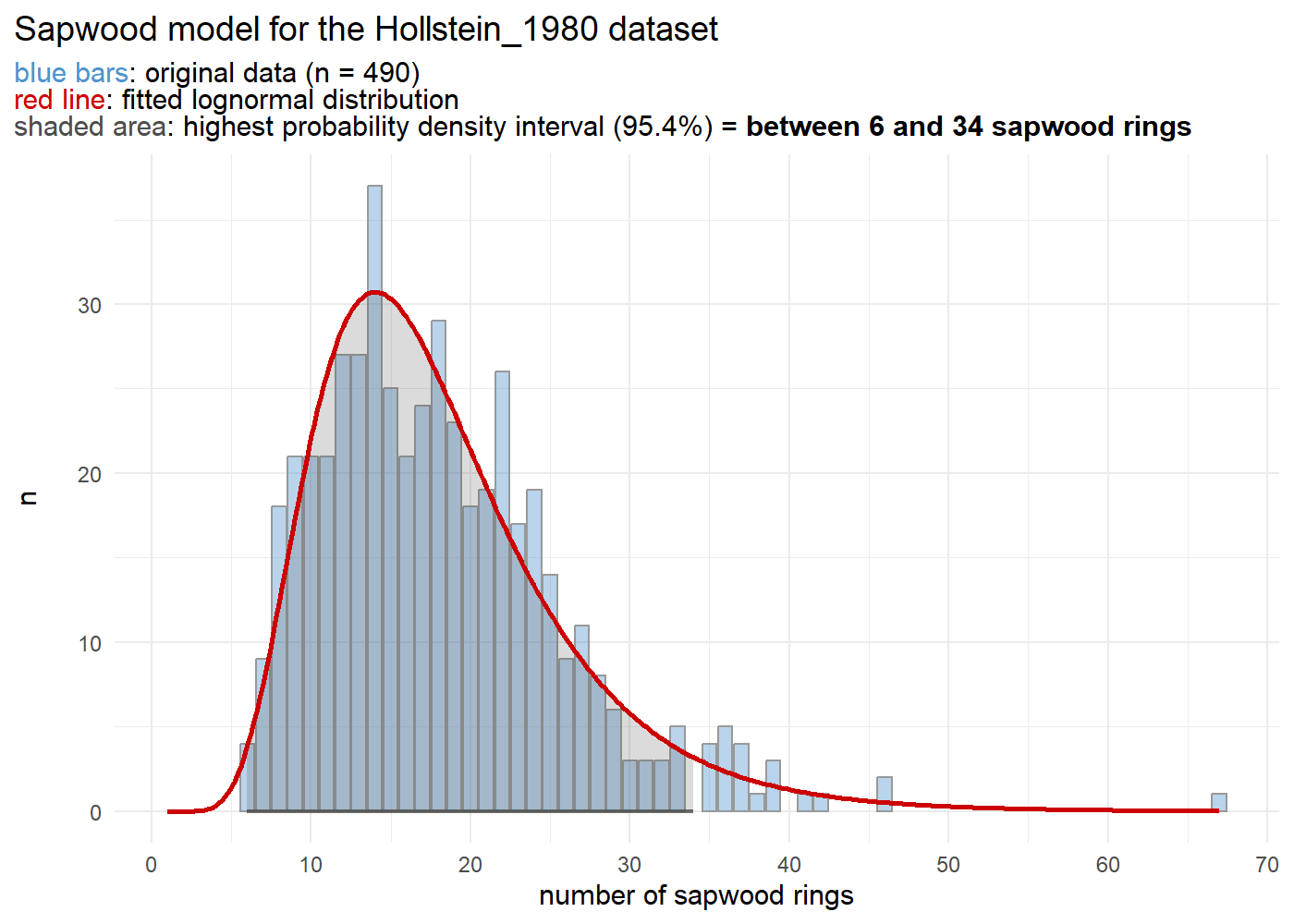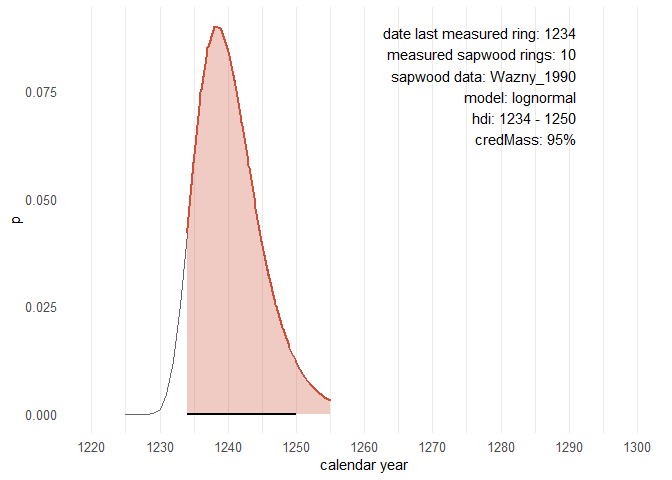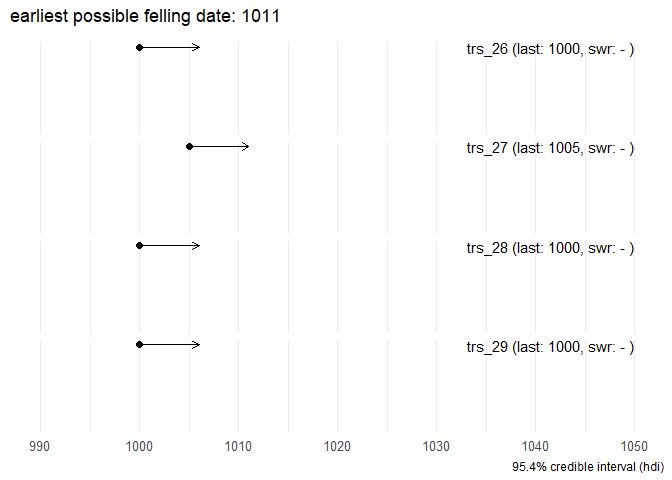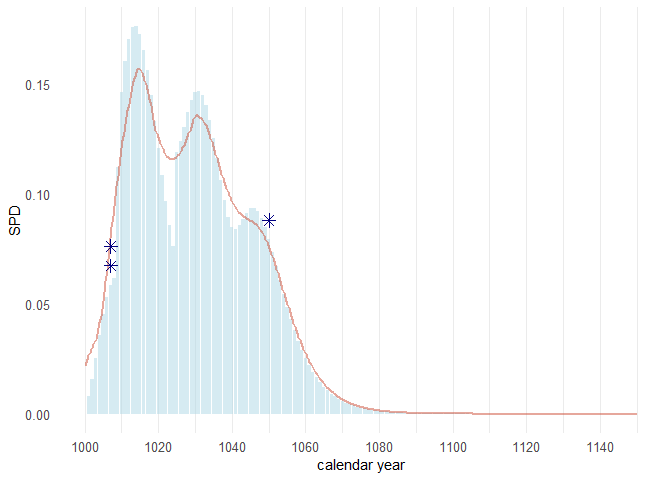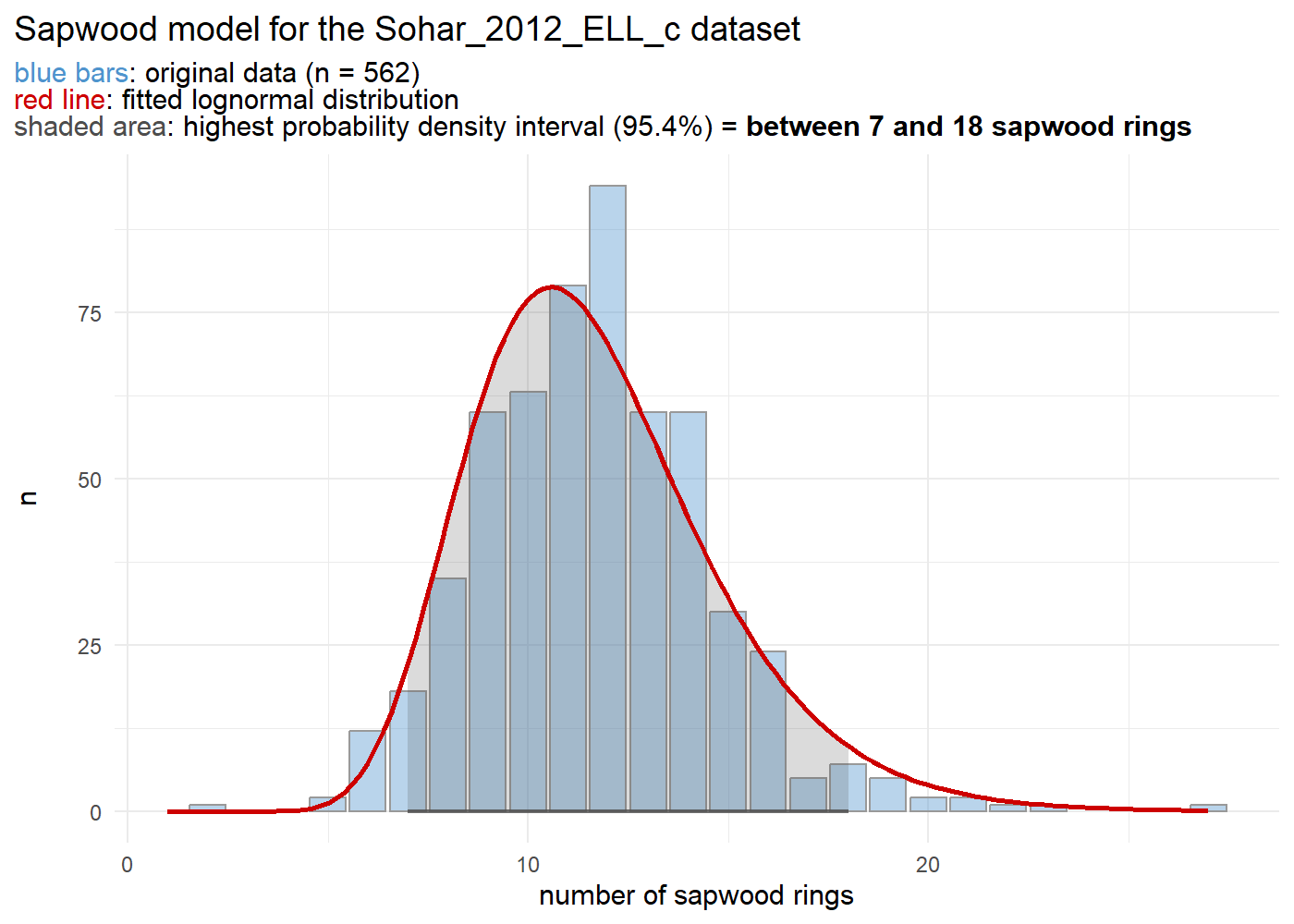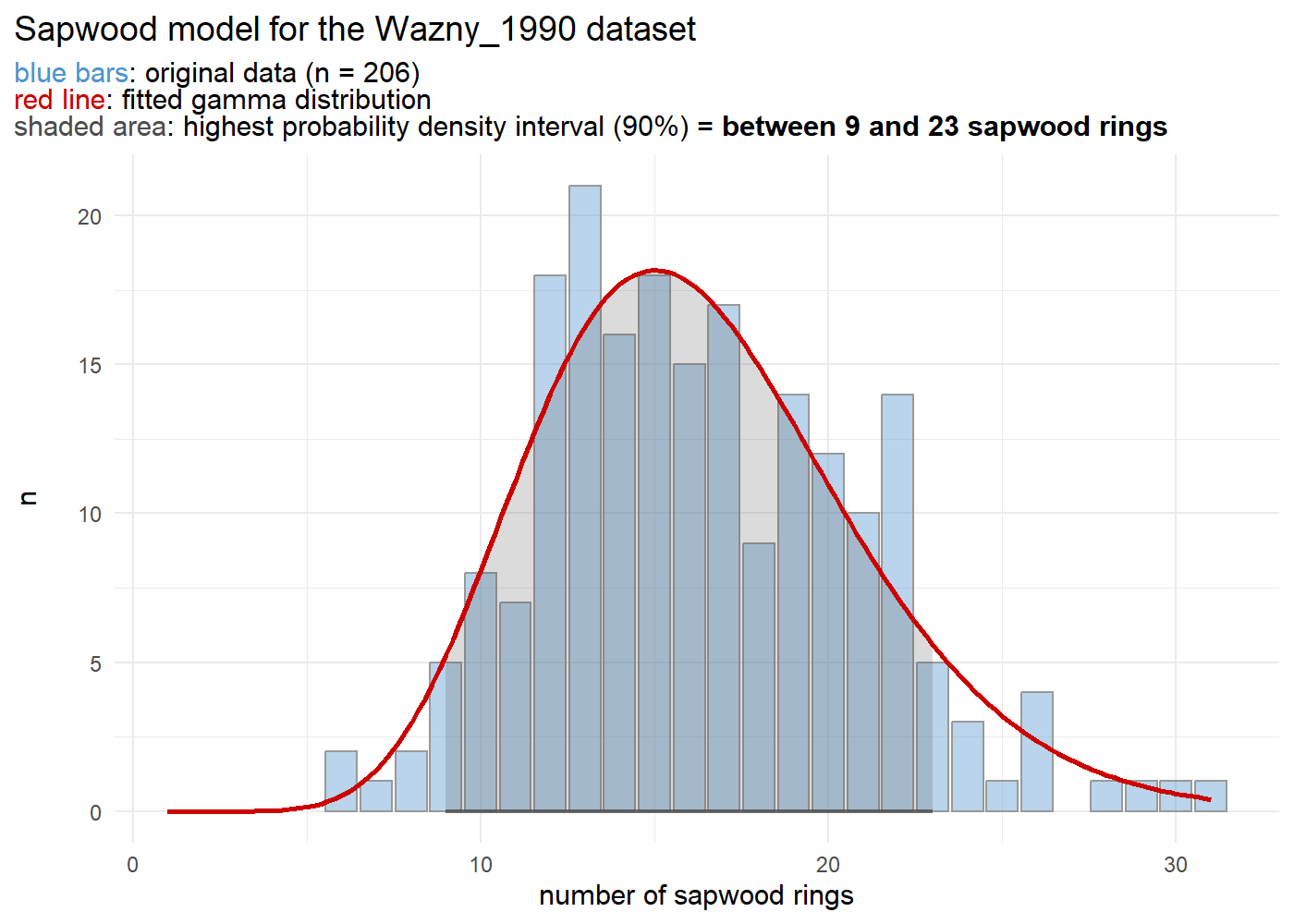This R-package offers a set of functions that can assist you to infer felling date estimates from dated tree-ring series. The presence of (partially) preserved sapwood or waney edge allows to estimate a range for the actual felling date, for individual series as well as for a group of timbers. Furthermore, an additional function provides a tool to sum sapwood probability distributions, comparable to 'summed probability densities' commonly applied to sets of radiocarbon (14C) dates.
Where it can be assumed that a group of historical timbers were all felled at the same time (i.e. the same year), but due to the absence of the bark/cambial zone (waney edge) and the last formed tree ring this cannot be assessed, the preserved sapwood rings can be used to infer a date range for the felling date.
Taking into account the observed number of sapwood rings on all samples and combining them into a single estimate, is likely to provide a more accurate and precise estimate of the felling date year for the group of timbers under study.
You can install the development version of fellingddateR from GitHub with:
#install.packages("devtools")
devtools::install_github("hanecakr/fellingdateR")In the following example the combined felling date range for a set of four dated tree-ring series is computed:
library(fellingdateR)
## a data set where all series have partially preserved sapwood:
load("R/sysdata.rda")
dummy1
#> series last n_sapwood waneyedge
#> 1 trs_06 1000 5 FALSE
#> 2 trs_07 1009 10 FALSE
#> 3 trs_08 1007 15 FALSE
#> 4 trs_09 1005 16 FALSE
#> 5 trs_10 1010 8 FALSEsw_combine(dummy1, plot = TRUE)The sapwood data used in the example above was published by Hollstein in 1980:
sw_model("Hollstein_1980")This package was developed during the analysis of a large data set of tree-ring series that originate from medieval timber constructions in Bruges (Belgium). The results of this study were published in Dendrochronologia.
Kristof HANECA
, Vincent DEBONNE, Patrick HOFFSUMMER 2020. The ups and downs of the building trade in a medieval city: tree-ring data as proxies for economic, social and demographic dynamics in Bruges (c. 1200 -- 1500). Dendrochronologia 64, 125773.
https://doi.org/10.1016/j.dendro.2020.125773
This function computes the probability density function (PDF) and highest probability density interval (hdi) of the felling date range based on the observed number of sapwood rings, their chronological dating and the selected sapwood data and model.
In the example below, 10 sapwood rings were observed on a sample (last ring dated to 1234 AD) that is supposed to have a provenance in the Southern Baltic region (sapwood model published by Wazny, 1990). The hdi delineates an interval in which the actual felling date is most likely situated. It is the shortest interval within a probability distribution for a given probability mass or credible interval. The hdi summarizes the distribution by specifying an interval that spans most of the distribution, say 95% of it, as such that every point inside the interval has higher credibility than any point outside the interval.
sw_interval(n_sapwood = 10,
last = 1234,
hdi = TRUE,
credMass = .95,
sw_data = "Wazny_1990",
densfun = "lognormal")
#> lower upper p
#> 1 1234 1250 0.9611797When hdi = FALSE a matrix is returned with scaled p values for each number of observed sapwood rings.
The results of this procedure can be visualized by setting plot = TRUE.
# 10 sapwood rings observed and the Wazny 1990 sapwood model:
sw_interval(n_sapwood = 10,
last = 1234,
hdi = TRUE,
credMass = .95,
sw_data = "Wazny_1990",
densfun = "lognormal",
plot = T)Reporting estimates of the felling date range for individual series, is provided by the fd_report() function.
tmp <- data.frame(id = c("aaa", "bbb", "ccc"),
swr = c(10, 11, 12),
waneyedge = c(FALSE, FALSE,TRUE),
end = c(123, 456, 1789))
fd_report(tmp,
series = "id",
n_sapwood = "swr",
last = "end",
sw_data = "Wazny_1990")
#> series last n_sapwood waneyedge lower upper felling_date
#> 1 aaa 123 10 FALSE 123 139 between 123 and 139
#> 2 bbb 456 11 FALSE 456 471 between 456 and 471
#> 3 ccc 1789 12 TRUE NA 1789 in 1789The procedure to combine felling dates of a group of related, individual series with (partially) preserved sapwood, in order to narrow down the range of a common felling date is provided by the sw_combine() function. It returns a list with:
-
the pdf for the felling date of the individual series and the pdf of the model that combines these individual series (
$dataRaw), -
the hdi for the combined estimate of the common felling date (
$hdi_model), -
the Agreement index (
$A_comb) of the model, expressing how well the individual series fit into the model (ideally around 100%, and not lower than the critical threshold A_c = 60%) , -
an overview of the felling date range for the individual series (
$individual_series), and their Agreement index (A_i) to the combined model.
A data set with dated tree-ring series which all have partially preserved sapwood. The names of the variables in the data set are mapped to the parameters of the sw_combine() function. In the example below, the numeric output is returned:
dummy0
#> trs end swr bark
#> 1 trs_01 1000 5 FALSE
#> 2 trs_02 1009 10 FALSE
#> 3 trs_03 1007 15 FALSE
#> 4 trs_04 1005 16 FALSE
#> 5 trs_05 1010 8 FALSE
output_comb <- sw_combine(dummy0,
series = "trs",
last = "end",
n_sapwood = "swr",
waneyedge = "bark",
credMass = .954,
plot = FALSE
)
head(output_comb$rawData, 20)
#> year trs_01 trs_02 trs_03 trs_04 trs_05 COMB
#> 1 997 0.000000000 0.00000000 0.00000000 0.00000000 0.00000000 0.00000000
#> 2 998 0.000000000 0.00000000 0.00000000 0.00000000 0.00000000 0.00000000
#> 3 999 0.000000000 0.00000000 0.00000000 0.00000000 0.00000000 0.00000000
#> 4 1000 0.002920043 0.00000000 0.00000000 0.00000000 0.00000000 0.00000000
#> 5 1001 0.007851298 0.00000000 0.00000000 0.00000000 0.00000000 0.00000000
#> 6 1002 0.015599306 0.00000000 0.00000000 0.00000000 0.00000000 0.00000000
#> 7 1003 0.025306533 0.00000000 0.00000000 0.00000000 0.00000000 0.00000000
#> 8 1004 0.035601879 0.00000000 0.00000000 0.00000000 0.00000000 0.00000000
#> 9 1005 0.045144747 0.00000000 0.00000000 0.10472609 0.00000000 0.00000000
#> 10 1006 0.052957634 0.00000000 0.00000000 0.09893475 0.00000000 0.00000000
#> 11 1007 0.058523183 0.00000000 0.09804289 0.09196367 0.00000000 0.00000000
#> 12 1008 0.061729102 0.00000000 0.09445847 0.08434543 0.00000000 0.00000000
#> 13 1009 0.062750121 0.04946162 0.08923493 0.07649959 0.00000000 0.00000000
#> 14 1010 0.061925767 0.05802159 0.08294731 0.06873926 0.02599192 0.14283134
#> 15 1011 0.059661778 0.06411934 0.07607598 0.06128498 0.03656611 0.17493731
#> 16 1012 0.056362490 0.06763182 0.06899937 0.05428134 0.04636743 0.17756885
#> 17 1013 0.052391109 0.06875047 0.06199988 0.04781326 0.05439192 0.15578431
#> 18 1014 0.048051045 0.06784729 0.05527644 0.04192076 0.06010820 0.12180221
#> 19 1015 0.043581322 0.06536681 0.04895945 0.03661131 0.06340095 0.08684045
#> 20 1016 0.039160310 0.06175203 0.04312552 0.03186987 0.06444962 0.05745784
output_comb[-1]
#> $sapwood_data
#> [1] "Hollstein_1980"
#>
#> $sapwood_model
#> [1] "lognormal"
#>
#> $credMass
#> [1] 0.954
#>
#> $hdi_model
#> lower upper p
#> 1 6 34 0.9561277
#>
#> $hdi_combine
#> lower upper p
#> 1 1010 1018 0.9741642
#>
#> $individual_series
#> series last n_sapwood waneyedge lower upper A_i
#> 1 trs_01 1000 5 FALSE 1001 1029 122.0
#> 2 trs_02 1009 10 FALSE 1009 1033 132.3
#> 3 trs_03 1007 15 FALSE 1007 1029 103.9
#> 4 trs_04 1005 16 FALSE 1005 1026 78.9
#> 5 trs_05 1010 8 FALSE 1010 1036 108.5
#>
#> $A_comb
#> Overall agreement index (%)
#> 117.6
#>
#> $A_c
#> Critical threshold (%)
#> 60
#>
#> $model_summary
#> [1] "felling date range: 1010 - 1018"A data set with 5 tree-ring series of which one has an exact felling date:
dummy2
#> series last n_sapwood waneyedge
#> 1 trs_11 1000 5 FALSE
#> 2 trs_12 1005 10 FALSE
#> 3 trs_13 1008 NA FALSE
#> 4 trs_14 1000 1 FALSE
#> 5 trs_15 1010 3 TRUE
sw_combine(dummy2, plot = TRUE)A data set where all tree-ring series have been measured up to the waney edge:
dummy3
#> series last n_sapwood waneyedge
#> 1 trs_16 1000 5 TRUE
#> 2 trs_17 1005 10 TRUE
#> 3 trs_18 1008 NA TRUE
#> 4 trs_19 1000 1 TRUE
#> 5 trs_20 1010 NA TRUE
sw_combine(dummy3, plot = TRUE)An attempt to compute a common felling date for a group of tree-ring series. All series include partially preserved sapwood:
dummy4
#> series last n_sapwood waneyedge
#> 1 trs_21 1000 5 FALSE
#> 2 trs_22 1005 10 FALSE
#> 3 trs_23 1005 NA FALSE
#> 4 trs_24 1020 1 FALSE
#> 5 trs_25 1040 0 FALSE
sw_combine(dummy4, plot = TRUE)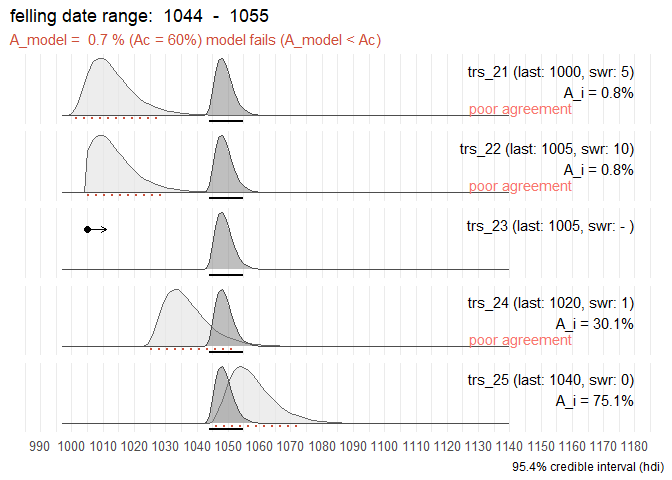 No common felling date can be computed for this particular data set. The model fails (agreement index of the model is below the critical threshold value (A_c) of 60%). Three series have an individual agreement index below 60%.
No common felling date can be computed for this particular data set. The model fails (agreement index of the model is below the critical threshold value (A_c) of 60%). Three series have an individual agreement index below 60%.
When no sapwood rings are observed and measured, only an earliest possible felling date (terminus post quem) can be determined:
dummy5
#> series last n_sapwood waneyedge
#> 1 trs_26 1000 NA FALSE
#> 2 trs_27 1005 NA FALSE
#> 3 trs_28 1000 NA FALSE
#> 4 trs_29 1000 NA FALSE
sw_combine(dummy5, plot = TRUE)The sw_sum() function computes the the summed probability density (SPD) for a set of felling date ranges.
sw_sum(dummy7, plot = TRUE)The function sw_data_overview() provides an overview of all published sapwood data sets that are distributed with this package.
sw_data_overview()
#> [1] "Brathen_1982" "Hollstein_1980" "Miles_1997_NM" "Miles_1997_SC"
#> [5] "Miles_1997_WBC" "Pilcher_1987" "Sohar_2012_ELL_c" "Sohar_2012_ELL_t"
#> [9] "Sohar_2012_FWE_c" "Sohar_2012_FWE_t" "Wazny_1990" "vanDaalen_NLBE"
#> [13] "vanDaalen_Norway"Load the original data with, e.g. get("Hollstein_1980").
More information on one of the sapwood data sets - how to cite the data set, the area the data represents, the number of observations and some basic summary stats - can be retrieved by the sw_data_info() function.
sw_data_info("Pilcher_1987")
#> $data
#> [1] "Pilcher_1987"
#>
#> $citation
#> [1] "Pilcher J.R. 1987. A 700 year dating chronology for northern France. Applications of tree-ring studies. Current research in dendrochronology and related subjects. BAR International Series 333, 127–139."
#>
#> $area
#> [1] "Northern France"
#>
#> $n_observations
#> [1] 116
#>
#> $summary_raw_data
#> Min. 1st Qu. Median Mean 3rd Qu. Max.
#> 12.00 22.00 26.00 26.72 31.00 49.00A graphical representation of a sapwood data set is provided by the sw_model() function.
sw_model("Sohar_2012_ELL_c")sw_data_info("Sohar_2012_ELL_c")
#> $data
#> [1] "Sohar_2012_ELL_c"
#>
#> $citation
#> [1] "Sohar K., Vitas A. & Läänelaid A. 2012. Sapwood estimates of pedunculate oak (Quercus robur L.) in eastern Baltic, Dendrochronologia 30.1, 49–56. DOI: https://doi.org/10.1016/j.dendro.2011.08.001"
#>
#> $area
#> [1] "Eastern Estonia, Latvia, Lithuania (sapwood determined by color)."
#>
#> $n_observations
#> [1] 562
#>
#> $summary_raw_data
#> Min. 1st Qu. Median Mean 3rd Qu. Max.
#> 2.00 10.00 12.00 11.69 13.00 27.00The sw_model() function allows to fit a distribution to a data set of observed sapwood numbers and computes the highest posterior density interval (hdi) for a given credibility mass. The density function fitted to the sapwood data set should be one of:
- "lognormal" (the default value),
- "normal",
- "weibull",
- "gamma".
The credible interval should be a value between 0 and 1.
sw_model("Wazny_1990", densfun = "gamma", credMass= .90, plot = TRUE)When plot = FALSE, a list with the numeric output of the modelling process is returned.
The read_fh() function is an extension to the dplR::read.fh() function from the dplR package (Bunn 2008, Bunn 2010, Bunn et al. 2022). It allows to read .fh (format Heidelberg) files of ring widths AND additional information found in the HEADER fields are listed as attributes.
This function also works with ring-width data in CHRONO and HALF-CHRONO format.
Furthermore, the read_fh() function is case insensitive.
Doel1 <- system.file("extdata", "DOEL1.fh", package = "fellingdateR")
Doel1_trs <- read_fh(Doel1, verbose = FALSE)
head(Doel1_trs, 15)
#> K1_091 S38-BB GD3-1BB GR1mBB GQ1mBB K1_095 GG1-1BB S13mSB S13A-BB S6-SB
#> 1150 NA NA NA NA 3.80 NA NA NA NA NA
#> 1151 NA NA NA NA 4.15 NA NA NA NA NA
#> 1152 NA NA NA NA 4.63 NA NA NA NA NA
#> 1153 NA NA NA NA 4.31 NA NA NA NA NA
#> 1154 NA NA NA NA 3.97 NA NA NA NA NA
#> 1155 NA NA NA NA 4.10 NA NA NA NA NA
#> 1156 NA NA NA NA 2.02 NA NA NA NA NA
#> 1157 NA NA NA NA 3.24 NA NA NA NA NA
#> 1158 2.50 NA NA NA 3.75 NA NA NA NA NA
#> 1159 2.73 NA NA NA 3.07 NA NA NA NA NA
#> 1160 2.27 NA NA NA 4.19 NA NA NA NA NA
#> 1161 1.44 NA NA NA 3.74 NA NA NA NA NA
#> 1162 1.47 NA NA NA 4.54 NA NA NA NA NA
#> 1163 2.29 NA NA NA 4.61 NA NA NA NA NA
#> 1164 2.83 NA NA NA 3.91 NA NA 1.84 NA NAWhen header = TRUE, the get_header() function is triggered and HEADER fields in the .fh file are returned as a data.frame.
read_fh(Doel1, verbose = FALSE, header = TRUE)
#> series data_type chrono_members species first last length swr
#> 1 K1_091 Single <NA> QUSP 1158 1292 135 15
#> 2 S38-BB Single <NA> QUSP 1193 1306 114 0
#> 3 GD3-1BB Single <NA> QUSP 1222 1310 89 5
#> 4 GR1mBB Quadro K1_001,K1_004x,GR1-3BB QUSP 1220 1310 91 3
#> 5 GQ1mBB Quadro GQ1-2BB,K1_007,K1_009 QUSP 1150 1314 165 7
#> 6 K1_095 Single <NA> QUSP 1207 1320 114 21
#> 7 GG1-1BB Single <NA> QUSP 1240 1322 83 13
#> 8 S13mSB Quadro S1-3SB,K1_076 QUSP 1164 1322 159 20
#> 9 S13A-BB Single <NA> QUSP 1232 1324 93 19
#> 10 S6-SB Single <NA> QUSP 1221 1324 104 14
#> swr_note unmeasuredRings status waneyedge bark pith pith_offset
#> 1 <NA> NA Dated <NA> <NA> - NA
#> 2 <NA> NA Dated <NA> <NA> - NA
#> 3 <NA> NA Dated <NA> <NA> - NA
#> 4 <NA> NA Dated --- - - NA
#> 5 <NA> NA Dated --- - - NA
#> 6 <NA> NA Dated <NA> - - NA
#> 7 <NA> NA Dated <NA> <NA> <NA> NA
#> 8 <NA> NA Dated --- <NA> - NA
#> 9 <NA> 1 Dated WKE <NA> <NA> NA
#> 10 <NA> 1 Dated WKE <NA> <NA> NA
#> comments project
#> 1 keelplank Ship timbers DOEL 1
#> 2 HW/SW boundary | K1_281 | framing timber Ship timbers DOEL 1
#> 3 K1_370 | hull plank Ship timbers DOEL 1
#> 4 hull plank Ship timbers DOEL 1
#> 5 hull plank Ship timbers DOEL 1
#> 6 inner stem Ship timbers DOEL 1
#> 7 hull plank <NA>
#> 8 average of S1-3SB,K1_076 | framing timber Ship timbers DOEL 1
#> 9 framing timber Ship timbers DOEL 1
#> 10 framing timber <NA>
#> location town zip street sampling_date personal_id
#> 1 Doel_Deurganckdok <NA> <NA> <NA> <NA> <NA>
#> 2 Doel_Deurganckdok <NA> <NA> <NA> <NA> <NA>
#> 3 Doel_Deurganckdok <NA> <NA> <NA> <NA> <NA>
#> 4 Doel_Deurganckdok Doel <NA> Deurganckdok <NA> Kristof Haneca
#> 5 Doel_Deurganckdok Doel <NA> Deurganckdok <NA> Kristof Haneca
#> 6 Doel_Deurganckdok Doel <NA> Deurganckdok <NA> Kristof Haneca
#> 7 KOGGE ANTWERPEN GG1-1BB <NA> <NA> <NA> <NA> EH
#> 8 Doel_Deurganckdok <NA> <NA> <NA> <NA> <NA>
#> 9 Doel_Deurganckdok <NA> <NA> <NA> <NA> KH
#> 10 KOGGE ANTWERPEN S6-SB <NA> <NA> <NA> <NA> EH
#> client_id longitude latitude
#> 1 <NA> <NA> <NA>
#> 2 <NA> <NA> <NA>
#> 3 <NA> <NA> <NA>
#> 4 <NA> <NA> <NA>
#> 5 <NA> <NA> <NA>
#> 6 <NA> <NA> <NA>
#> 7 <NA> <NA> <NA>
#> 8 <NA> <NA> <NA>
#> 9 <NA> <NA> <NA>
#> 10 <NA> <NA> <NA>